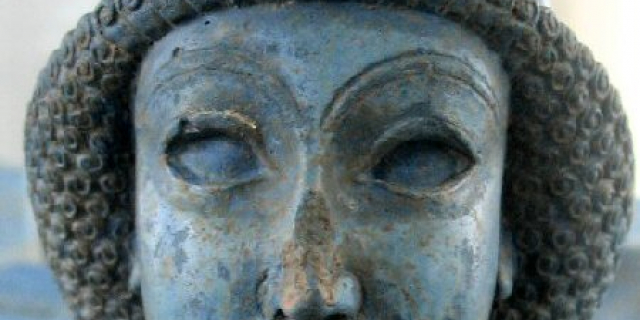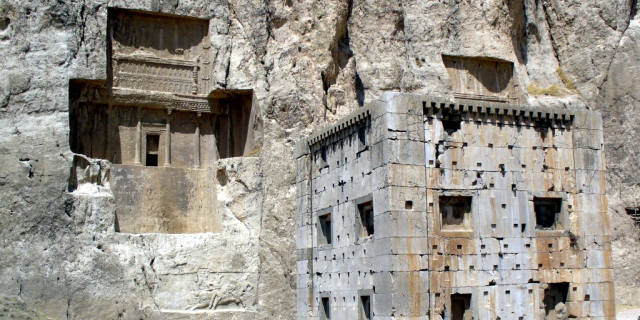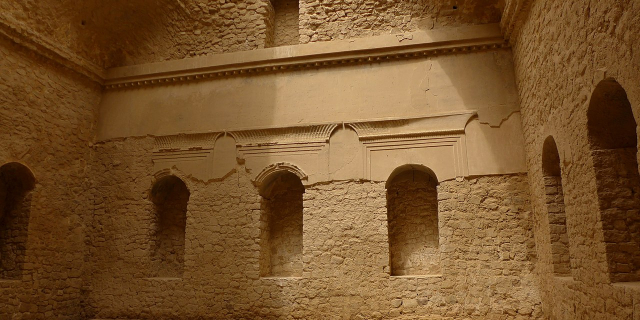Persepolis (; Old Persian: 𐎱𐎠𐎼𐎿, romanized: Pārsa; New Persian: تخت جمشید, romanized: Takht-e Jamshīd, lit. 'Throne of Jamshid') was the ceremonial capital of the Achaemenid Empire (c. 550–330 BC). It is situated in the plains of Marvdasht, encircled by southern Zagros mountains of the Iranian plateau. Modern day Shiraz is situated 60 km (37 mi) southwest of the ruins of Persepolis. UNESCO declared the ruins of Persepolis a World Heritage Site in 1979.
The earliest remains of Persepolis date back to 515 BC. The city, acting as a major center for the empire, housed a palace complex and citadel designed to...Read more
Persepolis (; Old Persian: 𐎱𐎠𐎼𐎿, romanized: Pārsa; New Persian: تخت جمشید, romanized: Takht-e Jamshīd, lit. 'Throne of Jamshid') was the ceremonial capital of the Achaemenid Empire (c. 550–330 BC). It is situated in the plains of Marvdasht, encircled by southern Zagros mountains of the Iranian plateau. Modern day Shiraz is situated 60 km (37 mi) southwest of the ruins of Persepolis. UNESCO declared the ruins of Persepolis a World Heritage Site in 1979.
The earliest remains of Persepolis date back to 515 BC. The city, acting as a major center for the empire, housed a palace complex and citadel designed to serve as the focal point for governance and ceremonial activities. It exemplifies the Achaemenid style of architecture. The complex was taken by the army of Alexander the Great in 330 BC, and soon after, its wooden parts were completely destroyed by fire, likely deliberately.
The function of Persepolis remains unclear. It was not one of the largest cities in Persia, let alone the rest of the empire, but appears to have been a grand ceremonial complex that was only occupied seasonally; the complex was raised high on a walled platform, with five "palaces" or halls of varying size, and grand entrances. It is still not entirely clear where the king's private quarters actually were. Until recently, most archaeologists held that it was primarily used for celebrating Nowruz, the Persian New Year, held at the spring equinox, which is still an important annual festivity in modern Iran. The Iranian nobility and the tributary parts of the empire came to present gifts to the king, as represented in the stairway reliefs. It is also unclear what permanent structures there were outside the palace complex; it may be better to think of Persepolis as only one complex rather than a "city" in the usual sense.
The exploration of Persepolis from the early 17th century led to the modern rediscovery of cuneiform writing and, from detailed studies of the trilingual Achaemenid royal inscriptions found on the ruins, the initial decipherment of cuneiform in the early 19th century.
Archaeological evidence shows that the earliest remains of Persepolis date back to 515 BC. André Godard, the French archaeologist who excavated Persepolis in the early 1930s, believed that it was Cyrus the Great who chose the site of Persepolis, but that it was Darius I who built the terrace and the palaces. Inscriptions on these buildings support the belief that they were constructed by Darius.
With Darius I, the sceptre passed to a new branch of the royal house. The country's true capitals were Susa, Babylon and Ecbatana. This may be why the Greeks were not acquainted with the city until Alexander the Great took and plundered it.
 Darius the Great, by Eugène Flandin (1840)
Darius the Great, by Eugène Flandin (1840) Persepolis in 1920s, photo by Harold Weston
Persepolis in 1920s, photo by Harold WestonDarius I's construction of Persepolis was carried out parallel to that of the Palace of Susa.[1] According to Gene R. Garthwaite, the Susa Palace served as Darius' model for Persepolis.[2] Darius I ordered the construction of the Apadana and the Council Hall (Tripylon or the "Triple Gate"), as well as the main imperial Treasury and its surroundings. These were completed during the reign of his son, Xerxes I. Further construction of the buildings on the terrace continued until the downfall of the Achaemenid Empire.[3] According to the Encyclopædia Britannica, the Greek historian Ctesias mentioned that Darius I's grave was in a cliff face that could be reached with an apparatus of ropes.[4]
Around 519 BC, construction of a broad stairway was begun. Grey limestone was the main building material used at Persepolis. The uneven plan of the terrace, including the foundation, acted like a castle, whose angled walls enabled its defenders to target any section of the external front.


 Bust of Alexander the Great, British Museum
Bust of Alexander the Great, British MuseumAfter invading Achaemenid Persia in 330 BC, Alexander the Great sent the main force of his army to Persepolis by the Royal Road. Diodorus Siculus writes that on his way to the city, Alexander and his army were met by 800 Greek artisans who had been captured by the Persians. Most were elderly and suffered some form of mutilation, such as a missing hand or foot. They explained to Alexander the Persians wanted to take advantage of their skills in the city but handicapped them so they could not easily escape. Alexander and his staff were disturbed by the story and provided the artisans with clothing and provisions before continuing on to Persepolis. Diodorus does not cite this as a reason for the destruction of Persepolis, but it is possible Alexander started to see the city in a negative light after this encounter.[5]
Upon reaching the city, Alexander stormed the "Persian Gates", a pass through modern-day Zagros Mountains. There Ariobarzanes of Persis successfully ambushed Alexander the Great's army, inflicting heavy casualties. After being held off for 30 days, Alexander the Great outflanked and destroyed the defenders. Ariobarzanes himself was killed either during the battle or during the retreat to Persepolis. Some sources indicate that the Persians were betrayed by a captured tribal chief who showed the Macedonians an alternate path that allowed them to outflank Ariobarzanes in a reversal of Thermopylae. After several months, Alexander allowed his troops to loot Persepolis.
 "The Burning of Persepolis", led by Thaïs, 1890, by Georges-Antoine Rochegrosse
"The Burning of Persepolis", led by Thaïs, 1890, by Georges-Antoine RochegrosseAround that time, a fire burned "the palaces" or "the palace".
It is believed that the fire which destroyed Persepolis started from Hadish Palace, which was the living quarters of Xerxes I, and spread to the rest of the city.[6] It is not clear if the fire was an accident or a deliberate act of revenge for the burning of the Acropolis of Athens during the second Persian invasion of Greece. Many historians argue that, while Alexander's army celebrated with a symposium, they decided to take revenge against the Persians.[7] If that is so, then the destruction of Persepolis could be both an accident and a case of revenge. The fire may also have had the political purpose of destroying an iconic symbol of the Persian monarchy that might have become a focus for Persian resistance.
Several much later Greek and Roman accounts (including Arrian, Diodorus Siculus and Quintus Curtius Rufus) describe that the burning was the idea of Thaïs, mistress of Alexander's general Ptolemy I Soter, and possibly of Alexander himself. She is said to have suggested it during a very drunken celebration, according to some accounts to revenge the destruction of Greek sanctuaries (she was from Athens), and either she or Alexander himself set the fire going.[8]
 Thaïs setting fire to Persepolis
Thaïs setting fire to PersepolisThe Book of Arda Wiraz, a Zoroastrian work composed in the 3rd or 4th century, describes Persepolis' archives as containing "all the Avesta and Zend, written upon prepared cow-skins, and with gold ink", which were destroyed. Indeed, in his Chronology of the Ancient Nations, the native Iranian writer Biruni indicates unavailability of certain native Iranian historiographical sources in the post-Achaemenid era, especially during the Parthian Empire. He adds: "[Alexander] burned the whole of Persepolis as revenge to the Persians, because it seems the Persian King Xerxes had burnt the Greek City of Athens around 150 years ago. People say that, even at the present time, the traces of fire are visible in some places."[7][9]
Paradoxically, the event that caused the destruction of these texts may have helped in the preservation of the Persepolis Administrative Archives, which might otherwise have been lost over time to natural and man-made events.[10] According to archaeological evidence, the partial burning of Persepolis did not affect what are now referred to as the Persepolis Fortification Archive tablets, but rather may have caused the eventual collapse of the upper part of the northern fortification wall that preserved the tablets until their recovery by the Oriental Institute's archaeologists.[11]
After the fall of the Achaemenid Empire Faravahar symbol in Persepolis
Faravahar symbol in PersepolisIn 316 BC, Persepolis was still the capital of Persia as a province of the great Macedonian Empire (see Diodorus Siculus xix, 21 seq., 46; probably after Hieronymus of Cardia, who was living about 326). The city must have gradually declined in the course of time. The lower city at the foot of the imperial city might have survived for a longer time;[12] but the ruins of the Achaemenids remained as a witness to its ancient glory.
The nearby Estakhr gained prominence as a separate city very shortly after the decline of Persepolis. It appears that much of Persepolis' rubble was used for the building of Istakhr.[13] At the time of the Muslim invasion of Persia, Estakhr offered a desperate resistance. It was still a place of considerable importance in the first century of Islam, although its greatness was speedily eclipsed by the new metropolis of Shiraz. In the 10th century, Estakhr dwindled to insignificance. During the following centuries, Estakhr gradually declined, until it ceased to exist as a city.































Add new comment